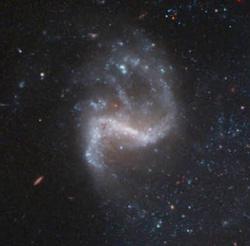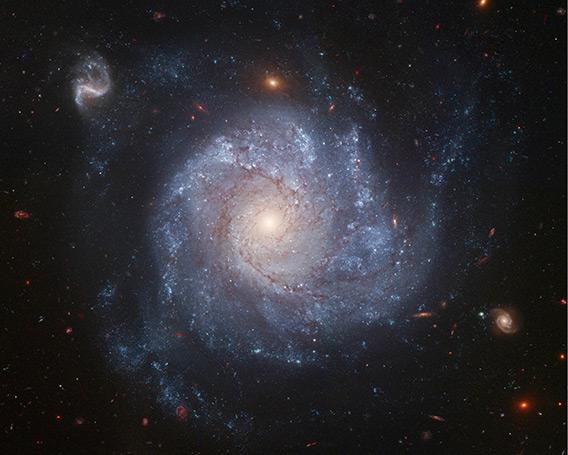This week’s Monday Galaxy was something of a surprise for me.
When I find a beautiful Hubble picture of a galaxy with which I’m not familiar, the first thing I do is hit the journals and databases. How far away is it? Why was it observed?
That first one was easy: This galaxy, called NGC 1309, is about 90 million light years away, give or take, putting it at the far side of what we might call “nearby”. Still with Hubble’s incredible vision, NGC 1309 is displayed in amazing detail (grab the 2400 x 3200 pixel version to see for yourself).
The answer to the second question, at first, eluded me. I dove right into the professional journals and extragalactic databases, looking to see what was going on with this galaxy. I found nothing. No mention of a huge black hole gobbling down matter and blasting out jets, no recent merger with another galaxy, no anomalously bright high-energy sources in it.
Then I laughed. I realized I didn’t actually read the synopsis of the observation on the Hubble website; I jumped right into the deep end. But when I read the short description, it became clear why NGC 1309 was targeted: It turns out, while overall the galaxy itself is scientifically unremarkable, it’s what’s in it that makes it special.
NGC 1309 has quite a few stars in it that are called Cepheid variables. These are massive, bright stars that pulsate in brightness on a regular schedule lasting a few days to months. The pulsation period of a Cepheid depends on the absolute brightness of the star, how much energy it emits. By measuring how bright the star appears over time, then, we can determine how bright the star actually is. That in turn allows us to measure its distance (since stars dim with distance in a relatively easy-to-measure way). Since we can see Cepheids in distant galaxies, that allows us to measure the actual distance to these galaxies.
That fact, all by itself, is amazing.
But NGC 1309 has another trick up its arm. On top of the Cepheids, in 2002 an exploding star was spotted in the galaxy, and it was of the kind that can also be calibrated to calculate its distance. This kind of supernova is used to measure the distances of galaxies that are incredibly far away, billions of light years distant, clear to the edge of the observable Universe. Being able to find a galaxy with both Cepheid stars and this type of supernova is a rare chance to match the two scales up and make sure they fit. It helps us bootstrap the size and behavior of the entire Universe.
Incredible.
That’s why NGC 1309 found itself in Hubble’s crosshairs. But to my amusement, that’s it. It’s otherwise a completely ordinary spiral galaxy, slightly smaller than our Milky Way, with wide-flung spiral arms festooned with dark dust lanes. Scientifically, if I saw NGC 1309 in a database or journal table, I wouldn’t give it a second glance.
That would be a shame, because it’s gorgeous.

Image credit: NASA, ESA, The Hubble Heritage Team, (STScI/AURA) and A. Riess (STScI)
Two other things did draw my attention in the Hubble image. First was the bizarre, smaller galaxy to the upper left. It has almost no defined nucleus, possesses that weird bar across it, and then has those kinked and messed-up arms. What’s its story? It looks like it recently had a collision with another galaxy that disrupted its structure, but I’m not sure. After some time online poking through databases, all I could find about it was how bright it is (17th mag, for those keeping notes at home, or 0.004% as bright as the faintest star you can see with your naked eye). That’s it. I suspect this Hubble image is the first detailed picture of it ever taken, so it’s not been studied thoroughly yet.
Second, I’ll note all the myriad background galaxies, so commonly seen in images like this. Interestingly, they appear to tend toward the red, which makes me think that NGC 1309 has a lot of dust in its outskirts; blue light passing through dust gets absorbed or scattered away, while red light passes through. It’s possible all those galaxies are intrinsically red, but it seems unlikely. Another mystery to pass on to someone who may one day study this lovely spiral galaxy.
I also find it somewhat funny that, above, I described this incredible object, so huge, so fantastically beautiful, as “unremarkable”. Perhaps as a galaxy itself it’s typical, one of many, a big spiral among countless thousands known. Yet it possesses the keys to our understanding of the Universe itself.
Unremarkable, indeed.
Tip o’ the lens cap to APOD, which has a slightly different version of this image, reprocessed by Martin Pugh.
